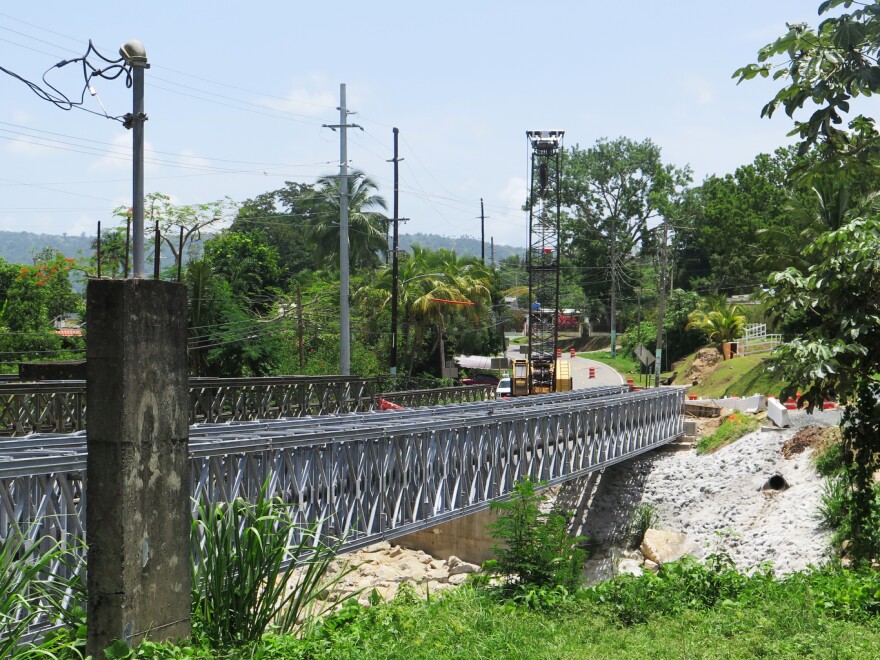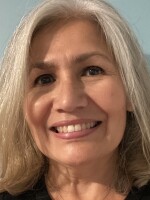Nearly two years after Hurricane Maria, the town of Utuado is finally getting a new bridge over the Viví River to replace the old concrete and steel one that was heavily damaged during the storm and has been closed ever since.
"This is the main road in and out of town," Héctor Cruz says, as a crew uses a crane and other heavy equipment to construct the new bridge. Cruz is the director of emergency management in Utuado, a community in the highlands of central Puerto Rico.
After the storm, massive landslides and downed trees blocked mountain roads, cutting the town off from the rest of the island for weeks. Many residents have not rebuilt their homes, and many roofs are still covered with blue tarps. If a hurricane hits Puerto Rico this season, it would be a huge setback, Cruz says. "We will have even more washed out roads, less access," he says. "We'll have the same level of destruction, and next time the problems will be even worse because many things have not been addressed yet."
Rebuilding is going slowly all over the island. Congress has allocated some $20 billion to rebuild houses and infrastructure, but while planning is going forward, very little of that money has been disbursed.

And it is hurricane season again. So many residents and communities across the island are getting ready by repairing buildings and homes, converting to solar energy, banding together and doing most of that without a lot of government help.
"What happened in Maria can happen again," says the director of Puerto Rico's Bureau of Emergency Management, Carlos Acevedo. But Acevedo says Puerto Rico is much better prepared than it was two years ago.
The island now has a detailed disaster response plan — something it didn't have when Maria hit. "I feel proud of what we've done in Puerto Rico," Acevedo says. "I trust that the government response in Puerto Rico to a hurricane would be very different this season from Maria's. We have much more information, much better logistics."
Acevedo says his agency has placed warehouses around the island stocked with emergency provisions. There's a plan for delivering fuel and agreements with utility companies on the mainland to respond quickly to restore power after a disaster. Another major improvement is communication. All of the island's 78 municipalities now have satellite phones and radios to ensure they won't lose contact with the outside world as they did during Hurricane Maria.
But for many, the main concern is the state of people's homes. A Federal Emergency Management Agency assessment found nearly every building in Puerto Rico was damaged by the storm, and many say their houses are not safe to shelter in.

"Now we have more than a half-million people affected, and we have to build at a minimum 75,000 homes," says Astrid Díaz, an architect who was part of a FEMA team that assessed the island's infrastructure. "That challenge is very big."
Few communities were hit harder during the storm than Toa Baja, a town just west of San Juan, the island's capital city. After torrential rains during Maria, the government opened the gates of a nearby dam, causing extensive flooding in the area.
Yarilin Colón is the president of Toaville, a neighborhood in Toa Baja. She says about a third of the homes in her neighborhood are abandoned. "I worry about that because they bring in vandalism. There are two abandoned homes across the street from my house, and I don't feel safe," she says.
Colón's house lost its roof. Before Maria, she made her money as a seamstress, but the studio on the first floor of her house was destroyed. Because she and her husband have a mortgage to pay, she says they have no choice but to stay. She has organized her community to rebuild and prepare for the next hurricane. "It would be good to get help from the government," she says. "But we are not waiting for the government here. We are helping ourselves."

Marilian Vázquez, who lives close by, is still reeling from the storm, too. Her home was heavily damaged and her husband's ice cream truck was destroyed. He fell into a deep depression, she says, and hasn't worked since.
"We haven't seen anything done in Toaville to make us feel safer," she says, as tears roll down her cheeks. "The authorities haven't done anything to better channel the river water flow. We haven't seen any cleanup of the drain system. I don't feel safe."
Her sons and in-laws live in the neighborhood, and she says that's what leaves her conflicted about the damaged area. "I'd like to move," she says, "though Toaville is a very nice place. It's peaceful, we are a close-knit community. I have great neighbors. ... It's not easy."
Astrid Díaz, the architect who works to build resilient homes and communities, says that is something she hears a lot, even from people who live in unsafe areas. "The tradition in Puerto Rico is that generation after generation ... want to live in the same neighborhood," she says. "It's very difficult to try to relocate them." The challenge she says is to educate people in places like Toaville that they'll be better off in a neighborhood that is not prone to flooding.
Communities like Toa Baja, and others where residents have found little help from the government, are taking steps on their own to become more resilient and able to respond to disasters.

About an hour's drive southwest of Toa Baja, up narrow winding roads, there is Mameyes, a small mountain community. Since the storm, residents have opened a health clinic with help from foundations and charities. It is completely powered by solar panels, so as not to be reliant on the island's energy infrastructure in the event of another major storm.
The clinic serves seven rural communities, where many elderly people live who need lots of medical care. Before Maria, people had to travel an hour or more for health care, even for minor issues. The storm made health care even more critical, but Noelia Rivera, a 27-year-old nurse, says it took weeks for outside help to arrive. In her native Spanish, she says, "All the roads were impassable. They were washed out or covered with dirt. The road to Jayuya, to Utuado, to Arecibo, to Manatí, it was all blocked off. We had to clean out all the landslides. The community came together, but it was a huge job."

Residents here believe the health clinic will help make Mameyes self-sufficient and better able to respond in future disasters.
The community in Las Carolinas, a working-class neighborhood in Caguas, is trying to do the same. Here, volunteers cook and serve meals to be delivered around the neighborhood to disabled and elderly residents.
Mariseli O'Neill Fontana, a 19-year-old volunteer, stirs a big casserole of stewed beans. After the storm, with no power, damaged homes and supplies running low, O'Neill says people needed help. "Many lost their home," she says. "They couldn't afford to eat hot meals or even just buy food." And for many residents, that's still the case.
The group, called Center of Mutual Support, is staffed by volunteers who live in the neighborhood. After Maria, they opened the kitchen in an abandoned elementary school. Now one of the group's board members, Miguel Angel Rosario, says they're negotiating with the government to get the deed to the property. "Our plan is to power it on solar," he says. "We want to install solar panels here, especially in the kitchen, so we can continue to provide services to the community" in the event of another big storm.
The group in Las Carolinas has had help — funding from foundations and charities and guidance from Pablo Méndez, an associate professor of environmental health at the University of Puerto Rico. Méndez says that like Mameyes and Las Carolinas, "Some communities are rising up and not waiting for the support from the government. And they now have more confidence in making their own decisions."

Méndez has been working with 11 communities in Puerto Rico to help them identify their needs and take steps to become more resilient and self-sufficient. These are communities, he says, that have long felt ignored by the government — underserved areas that were hurting before the hurricane. They include "a lot of people that are living below the poverty level, people who are on unemployment, that don't have health insurance. What the hurricane did was to unveil some of the reality of how Puerto Ricans were living," he says.
As for Utuado, the small city up in the central mountain region of the island, things look much better than they did right after the storm. People are out in the town's square; stores are open; and the U.S., Puerto Rico and Utuado flags fly outside the colonial-era city hall. But the town's mayor, 36-year-old Ernesto Irizarry, says: "We will never be fully prepared for a hurricane." Utuado is smaller since the storm after losing about 10% of its population. Some schools have closed, but Irizarry says people are returning.
"Yes, we can be stronger," he says. "The important thing here is personal readiness — that you and your family are ready to survive for three weeks or a month without government help."

For people in Puerto Rico, two years after Hurricane Maria, that may be the storm's most important message. Being prepared means not being dependent on that government help.
Copyright 2023 NPR. To see more, visit https://www.npr.org.




